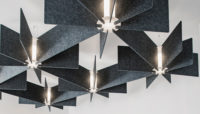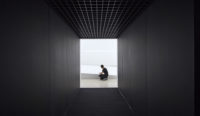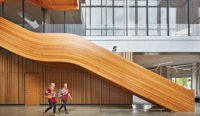Using textiles to dampen sound is nothing new, but up until the last several years, acoustical fabrics were traditionally opaque and heavy in appearance, relegating them mostly to wall, ceiling, and divider applications. Then in 2011, textile extraordinaire Annette Douglas changed the game by inventing the first translucent fabric with acoustical properties, thus opening the floodgates for designers to experiment with noise-controlling, light-transmitting drapery. Now in 2017, a handful of major contract fabric mills have built on Douglas’s breakthrough research to offer acoustical sheers in a wider range of colors, patterns, and openness.
A company that embraced this discovery early on, Carnegie has to date released eight semi-transparent, sound-absorbing window coverings—from Alphacoustic to Zetacoustic—by the Creation Baumann brand. Constructed with 100 percent Trevira CS polyester, the textile line boasts NRC ratings from .25 to .60 depending on the style and how it’s installed. Even more impressive, its Reflectacoustic not only allows light transmittance while absorbing sound, it also reduces solar heat gain.
Another brand making waves in this arena is Designtex, whose acoustic sheers have similar properties and appearance as Carnegie’s, with the exception of Glace, which introduces a geometric pattern. Composed of 94 percent Trevira CS polyester and 6 percent polyester, it sports a tone-on-tone grid of large polka dots in five neutral colorways. And Wolf-Gordon’s foray into acoustic sheers brings everything full circle: Its three curtain fabrics produced by Vescom are blended of Trevira CS polyester and polyester, have an NRC rating of .50 or .60, and were designed by Annette Douglas herself, the original inventor.







